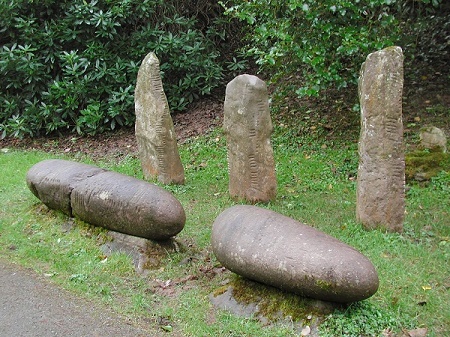Type: Ogham Stone
Townland: Baile an GhóilínlTownland of the little creeks

This stone is on the far right. Photo courtsey of Kathleen Reen
DINGLE MonumentCillvickillane/Cill Mhic Uíleáin:
A storm at the end of the 18th
century exposed 7 ogham stones, a possible fragment of an 8th ogham
stone, a cross-inscribed stone, a number of graves and quantities
of bone, and the ruins of several houses (Windele 1838, 145).
Windele's sketch of the site shows the ogham stones set out in a rough semi-circle
on top of the mound with a slab-lined grave positioned nearby.
Lord Ventry removed 6 of the ogham stones from the site in the mid-19th century;
Numbers 1 to 4 now line the driveway to Burnham House/Colaiste Íde (KE053-012004- , KE053-012005- , KE053-012006- ,
KE053-012007-), between Dingle and Ventry;
Numbers 5 and 6 are preserved in the grounds of Chute Hall (KE029-132----,
KE029-241----) near Tralee and no. 7 remains at the original site
(KE042-057003-).
The present location of this stone is at Coláiste Íde and its monument
number at that location is KE053-012006-
This stone stands 1.16m high and is c. 0.34m wide and 0.14m thick.
The reading of the full inscription is uncertain and only the following
letters survive:
( )NAVICAS MAQI MUCO(I) ( )S.
The scores preceding the N are extremely faint; O'Kelly (annotation to personal copy of Macalister's Corpus) and Windele (1848, 448) interpreted these as OD, whereas Macalister (1945, 146-7, no. 150) read G followed by R instead of N. The final word, occupying the diametrically opposed angle of the stone, is represented by only a single letter.
Macalister supplied the name DOVVINIAS here but no earlier accounts allude to this and it may have been a conjectural restoration.
(Cuppage 1986, no.792 (No. 3))
Orla Breslin.